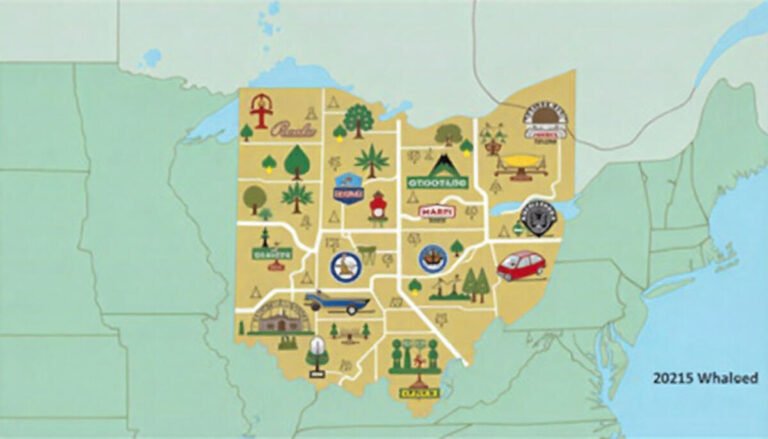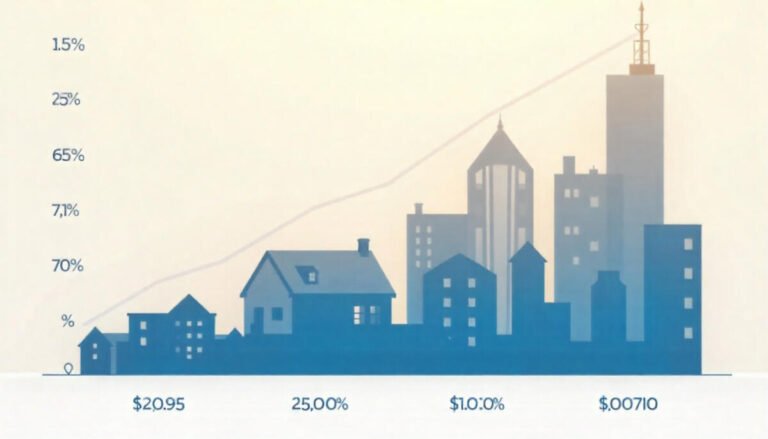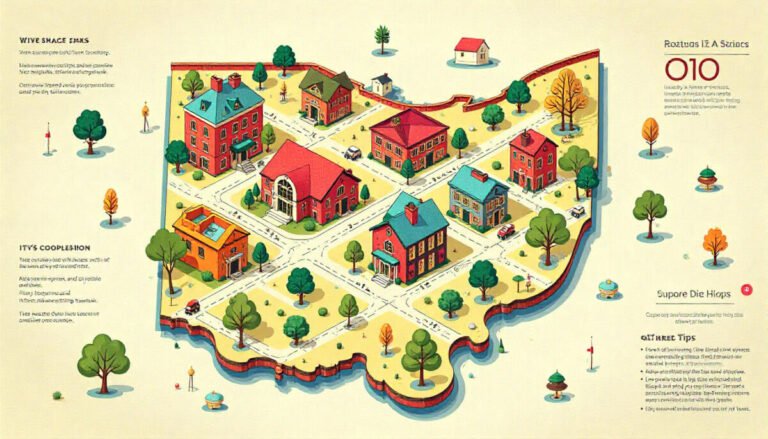If you’ve ever thought about moving to Ohio or just wondered what it’s like to live there in 2025, you’re not alone. Many people are drawn to the Buckeye State for its balance of affordability, job opportunities, and overall quality of life. Whether you’re a student, professional, or retiree, understanding the cost of living in Ohio can help you make smart financial decisions.
How Affordable Is Ohio in 2025?

Ohio continues to rank among the most affordable states in the U.S. In 2025, the overall cost of living here is roughly 15%–20% lower than the national average. That means your money stretches further in Ohio than in many other states, especially when it comes to housing and everyday expenses. According to World Population Review, Ohio’s cost of living index is 94.2 (U.S. average = 100). The state’s strongest affordability factors come from lower housing prices, cheaper utilities, and reasonable transportation costs.
1. Housing Costs in Ohio

Housing is where Ohio really shines. Compared to the rest of the country, homes and apartments are significantly cheaper here.
Median Home Price: Around $197,000 (versus the U.S. average of $338,000)
Average Rent: About $887/month for a one-bedroom and $1,141/month for a two-bedroom apartment
(Data source: Apartment List)
Cities like Youngstown, Dayton, and Akron consistently rank among the most affordable places to buy or rent. On the other hand, areas like Columbus and Cincinnati have seen higher housing demand, which slightly raises costs — but they still remain below national averages.
2. Transportation and Commuting Costs

Transportation costs in Ohio are relatively budget-friendly. Gas prices hover close to the national average, but shorter commutes and less congestion mean you’ll likely spend less on fuel and car maintenance.
If you live in larger cities like Columbus or Cleveland, public transportation options such as the Central Ohio Transit Authority (COTA) and Greater Cleveland RTA can further reduce travel expenses.
On average:
Monthly transportation costs range between $75 and $120 per person depending on lifestyle and location.
(Source: LivingCost.org)
3. Food and Grocery Prices

Groceries and dining out in Ohio are also quite reasonable. Most households spend around $400–$500 per month on groceries, depending on family size and eating habits.
A basic fast-food meal: $10–$12
A restaurant meal for two: $60–$65
(Source: LivingCost.org)
Local farmers’ markets across Ohio also make it easy to eat fresh, seasonal produce without overspending. Cities like Toledo and Cincinnati have excellent local food scenes that combine affordability with quality.
4. Utilities and Internet

Utility costs in Ohio are close to the national average, but still manageable. Expect to pay roughly $150–$200 per month for electricity, water, and heating combined for a small apartment. High-speed internet averages around $60–$75/month depending on the provider and speed.
During winter, heating costs may rise slightly, especially in northern cities like Cleveland or Akron. Choosing an energy-efficient apartment or home can make a big difference.
5. Healthcare and Insurance

Ohio’s healthcare expenses are about 10% lower than the national average, making it an attractive state for families and retirees. Health insurance premiums vary depending on your provider and plan, but most residents spend between $350 and $500 per month for decent coverage.
If you prefer more in-depth local healthcare data, visit United For ALICE Ohio Costs Over Time for state-specific updates.
6. Education and Childcare

For families, Ohio’s education system offers a range of affordable options. Public schools are generally good, and the state has some top-rated universities like Ohio State University, Case Western Reserve University, and University of Cincinnati.
Childcare, however, can vary. In cities like Columbus, daycare for one child can cost around $800–$1,000/month, while smaller towns may be closer to $600/month.
Most Affordable Cities to Live in Ohio (2025)

If you’re thinking about relocating, here are some of the most budget-friendly cities in Ohio right now:
1. Youngstown
Cost of living about 25% lower than the national average
Median home price under $120,000
Great for retirees and remote workers
2. Dayton
Affordable rental market and strong community vibe
Good job opportunities in aerospace and healthcare
Average rent around $900/month
3. Toledo
Ideal for families with access to Lake Erie
Affordable housing with a cost of living about 20% below U.S. average
Average home price around $160,000
4. Akron
A smaller, quieter city with big-city amenities
Strong public schools and lower grocery/transport costs
Average home value around $180,000
5. Columbus
The state capital and job hub
Slightly higher costs but strong salaries balance it out
One-bedroom rent: about $1,150/month
(Source: Purpose Jobs)
Average Monthly Budget Example
Here’s what a typical monthly budget might look like for a single person living comfortably in Ohio:
| Expense Category | Estimated Cost (USD) |
|---|---|
| Rent (1-bedroom) | $900 |
| Utilities & Internet | $180 |
| Groceries | $450 |
| Transportation | $100 |
| Healthcare | $250 |
| Entertainment & Misc. | $200 |
| Total | ≈ $2,080/month |
That’s roughly $25,000 per year, which is much lower than what you’d spend in cities like Chicago, New York, or Los Angeles.
Tips for Saving Money While Living in Ohio
Live slightly outside major downtowns — Suburban areas often have lower rent without sacrificing convenience.
Use public transport or carpool — Reduces fuel, parking, and maintenance costs.
Shop at local markets — Cheaper produce and supports local farmers.
Bundle internet and phone plans — Save $10–$20 monthly.
Take advantage of free city events — Ohio has great parks, festivals, and museums.
Final Thoughts
Ohio remains one of the most budget-friendly states to live in for 2025. With affordable housing, fair wages, and a comfortable lifestyle, it’s no surprise that more people are relocating here from higher-cost states.
Whether you’re settling in Columbus, exploring the charm of Dayton, or finding peace in Toledo, Ohio offers plenty of opportunities without breaking your bank account.
If you want to check detailed cost comparisons or use a calculator to plan your move, visit the RentCafe Cost of Living Calculator for an updated estimate.
Frequently Asked Questions (FAQs)
1. Is Ohio an affordable place to live in 2025?
Yes, Ohio is still considered one of the most affordable states to live in for 2025. Housing prices are well below the national average, and everyday expenses like groceries, utilities, and transportation are reasonably priced. The state’s overall cost of living index sits around 94.2, meaning your money goes further here compared to many U.S. states.
2. What is a good salary to live comfortably in Ohio?
For a single person, a salary of around $45,000–$50,000 per year is generally enough to live comfortably in most Ohio cities. For a small family, an annual income between $65,000 and $80,000 provides a comfortable lifestyle, covering housing, food, healthcare, and savings. Of course, living costs are higher in cities like Columbus and Cincinnati, while towns like Dayton and Toledo are more affordable.
3. Which city in Ohio has the lowest cost of living?
Youngstown consistently ranks as one of the most affordable cities in Ohio, with housing and utilities far below state averages. Toledo and Dayton also offer low housing costs and plenty of amenities for families and students. If affordability is your top priority, these smaller metro areas are excellent options.
4. How much does it cost to rent an apartment in Ohio in 2025?
Rent prices vary by city, but on average, you can expect to pay:
$850–$950 for a one-bedroom apartment
$1,100–$1,300 for a two-bedroom apartment
In Columbus or Cincinnati, rents may be slightly higher, while smaller cities like Akron and Youngstown are much cheaper. You can check updated rental data at Apartment List’s Ohio Cost of Living Guide.
5. Is Ohio a good place to move for remote work or retirement?
Absolutely. Ohio’s lower housing costs, quiet communities, and good access to healthcare make it a smart choice for retirees. For remote workers, affordable internet, coworking spaces, and stable utilities create an ideal work-from-home environment. Plus, its central U.S. location means easy access to nearby states for business or leisure travel.




